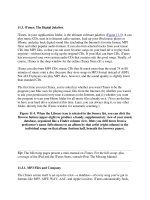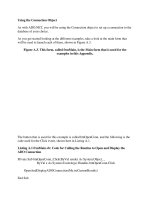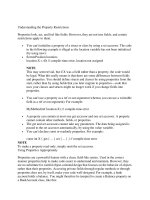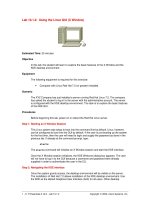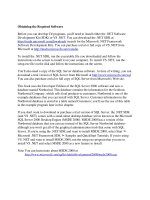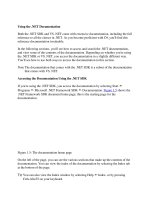Tài liệu Using the Navigation Pane pptx
Bạn đang xem bản rút gọn của tài liệu. Xem và tải ngay bản đầy đủ của tài liệu tại đây (29.61 KB, 8 trang )
[ Team LiB ]
Using the Navigation Pane
The Navigation Pane combines the Outlook Bar and Folder view from previous versions
of Outlook into one column. It provides the following layouts:
• A tree view of all mail folders with Favorite Folders shortcuts.
• Folder-only views for the Contacts, Notes, Tasks, and Journal folders. Folders are
listed by name; subfolders are not indented or otherwise identified as subfolders.
• Folder view for Calendar folders only. Calendar thumbnails are included in the
Navigation bar. Select check boxes to display multiple calendars side-by-side.
• Folder list view includes all folders. If you use Exchange Server, this is where
you'll find your public folders.
• Shortcuts that provide the functionality of the Outlook Bar found in older versions
of Outlook.
Buttons at the bottom of the Navigation Pane provide easy access to your Outlook
folders. You'll probably want to slide the buttons down to provide more space for your
folder lists. You can also select which buttons to show. Enabling the Current View
selection list displays a list of the views available for your folder following the folder list
in the Navigation Pane.
Customizing the Navigation Pane
By default, the Navigation Pane uses large buttons for Mail, Calendar, Contacts, and
Tasks, with smaller icons along the bottom row for Notes, Folder List, and Shortcuts (see
Figure 1.2
).
Figure 1.2. Select buttons on the Navigation Pane to move between Outlook folder
types.
When you use a high screen resolution, Outlook enables you to have larger buttons. You
have fewer buttons when you use a low resolution, such as 800x600. Click the arrows at
the bottom right to select which buttons are visible. By default, the Journal button is not
shown; I added it for the screenshot.
You can also reduce the buttons to one row:
1. Hover the mouse cursor over the bar resizing handle at the top of the Mail button.
2. Click and drag down or up to show or hide the full-sized buttons.
You can also control which shortcuts Outlook shows on the buttons and the order in
which they're listed:
1. Click on the arrow at the lower right of the Navigation Pane.
2. Choose Add or Remove Buttons and select the buttons you want to show and
deselect the ones you don't want to see.
3. Choose Navigation Pane Options to rearrange the order of the buttons, as shown in
Figure 1.3
.
Figure 1.3. Select a button name and then use the Move Up and Move Down
buttons to change the order in which the buttons appear. Uncheck any names
for which you don't want to include buttons. You can use the Go menu
instead of these buttons.
You're limited to using the buttons listed in Navigation Pane Options, so you can't add
buttons of your own.
The bottom button bar remains in the Navigation Pane, even if you
remove all the buttons from it. If you do remove buttons, you can use
the Go menu or keyboard shortcuts to move between folders.
Using All Mail Folders
Most people will spend the majority of their time in the All Mail folders view, or they
will after they get used to it. This display works like the Folder list, except only mail
folders are visible in this view.
You'll notice the Favorite Folders shortcut group at the top of the Navigation Pane. By
default, it includes your Inbox, Sent folder, and two Search Folders. You can right-click
on any mail folder to add it to the Favorite folders. Unfortunately, you can't add nonmail
folders to it or remove it from the view.
The All Mail Folders section includes the Outlook Today folder and all mail folders in
your profile. If you have HTTP (Hotmail) or IMAP accounts, those Inboxes are included
in the Favorite Folders list.
Exchange Server Public Folders aren't included in this view, although you can add Public
Folder Favorites to the Favorite Folders list.
Using the Navigation Bar with Outlook's Other Folders
The Navigation Pane looks much different when you're using Calendar, Contacts,
Journal, Notes, and Tasks folders. Instead of a tree view of your folders, you'll see a list
of the folders. When more than one message store is o
p
en, all the same type of folders are
listed in the My (folder) group.
A message store is where your messages are stored. When you use
an Internet email account, it's a Personal Folder store (PST).
Exchange Server users have an Exchange mailbox or an Offline
Store (OST) and can use a PST for archiving messages.
When you have shared folders opened, they'll be grouped below the ones in your message
store in the Other (folder) group, as seen in Figure 1.4
. This applies only to Exchange
Server users and Contacts and Calendar folders for SharePoint Portal Server users.
Figure 1.4. The Navigation Pane for all nonmail folders resembles this screenshot.
This figure shows a Contacts folder from my public folder store as well as shared
contacts from a SharePoint Portal Server.
Optionally, you can show the Current View selector at the bottom of the Navigation
Pane. Turn it on or off using View, Arrange By, Show Views in Navigation Pane. The
N
avigation Pane scrolls when you have many folders or views, making it less useful to
include views in the Navigation Pane. It's a per-folder group option, so you can turn it off
for some folder types and turn it on for the folders on which you change views most
often.
The final option found in the Navigation Pane is Customize Current View. You can't
create new views using this link, but it brings up the Customize dialog, enabling you to
modify or reset the current view.
Customizing views is covered in Hour 3, "Navigating the Outlook
Interface."
The Open Shared (folders) link is present in all profiles, but only
Exchange Server users can use it.
Outlook's Calendar
The Calendar's Navigation Pane has many changes from Outlook 2002 as well. As you
can see in Figure 1.5
, the most promising feature found in Outlook 2003 is the capability
to select multiple calendars and view them side-by-side in one window.
Figure 1.5. Outlook's new multiple calendar view displays selected calendars on
your screen.
The Navigation Pane displays a calendar thumbnail with two or more thumbnails shown
on a high-resolution monitor. The width of the Navigation Pane is adjustable up to one-
half of the screen width, which adds two or more thumbnails per row.
If you're familiar with the Calendar task pad and thumbnails on the right of the screen
from previous versions of Outlook and want to use it, you can restore that view by
dragging the right edge inward the width of a calendar thumbnail. The task pad and
thumbnails will appear on the right and the thumbnail in the Navigation Pane will
disappear.
If you don't use Exchange Server, you won't be able to use Open a
Shared Calendar or Share My Calendar. If you're using a SharePoint
server, you can view a read-only copy of the SharePoint calendar in
Outlook. The calendar will update automatically, but it's just a one-
way sync from SharePoint to your computer.
If you need to share your calendar with other SharePoint users, you
can export your calendar from Outlook to CSV or Microsoft Excel
format and import it to the SharePoint calendar.
More information on using the calendar is in Hour 11
, "Using Your
Calendar."
Using Shortcuts
The Shortcuts Navigation Pane replaces the Outlook Bar shortcuts used in older versions
of Outlook (see Figure 1.6
). Any type of shortcut, from Outlook folders to files and
programs on your computer to Internet shortcuts works on the Shortcuts bar.
Figure 1.6. Place any type of shortcut in the Navigation Pane's Shortcuts group.
Internet shortcuts open the Web page in Outlook's window; file system folders open
in Windows Explorer. Other files open the appropriate program.
Select the Add New Group link to add a new group to the list. Groups are listed in the
order you create them. To reorder the list, right-click on a group name and choose Move
Up the List and Move Down the List.
Right-click on a group and choose Remove Group. When you remove a group, all the
shortcuts in the group are also deleted.
Use Add a New Shortcut to add shortcuts to Outlook's folders. Create shortcuts to
Windows files and folders by opening Windows Explorer and dragging files, folders, or
existing shortcuts to the Shortcuts bar.
[ Team LiB ]
